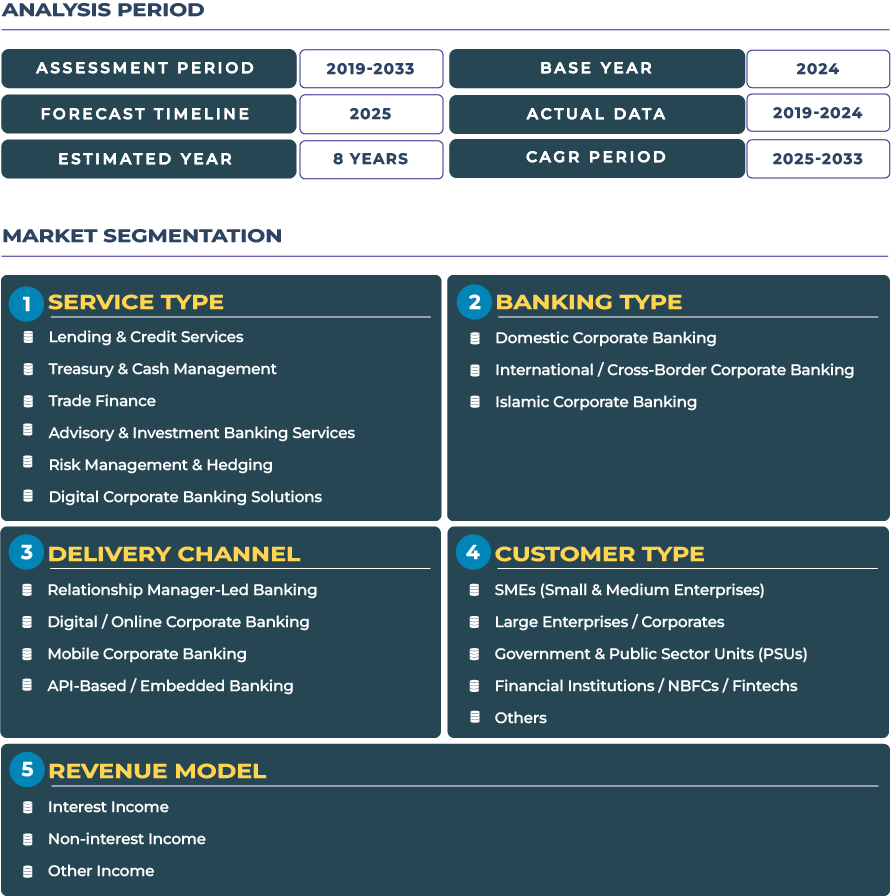Expanding Digital SME Lending in Eastern Europe: Unlocking Financing for Growing Enterprises
The Eastern Europe corporate banking market is evolving rapidly as banks transition from traditional corporate services to digitally enabled lending and treasury solutions. A major focus area across the region is the acceleration of digital SME lending and fintech collaboration to expand access to finance for underserved enterprises. Banks in markets such as Poland’s National Bank (NBP) and Russia’s Central Bank (CBR) are implementing frameworks to foster open banking and streamline SME credit assessment through data-driven credit scoring and digital onboarding.
Note:* The market size refers to the total revenue generated by banks through interest income, non-interest income, and other ancillary sources.
According to DataCube Research, the Eastern Europe Corporate Banking Market was valued at USD 70.5 billion in 2025 and is projected to reach USD 86.1 billion by 2033, expanding at a CAGR of 2.5% between 2025 and 2033. This growth reflects a strategic convergence between digital transformation and rising corporate financing needs across manufacturing, logistics, and technology sectors. The shift toward embedded digital corporate banking solutions and instant credit decisioning platforms represents the backbone of future competitiveness in this region.
Eastern Europe Corporate Banking Market Outlook: Digital Financial Inclusion Driving Corporate Growth Across Emerging Eastern Economies
The outlook for the Eastern Europe corporate banking industry remains positive as regional economies strengthen their trade, production, and investment ecosystems. Post-pandemic recovery efforts and continued EU support are fostering improved liquidity access for SMEs and corporates. A growing number of banks are offering digitally integrated treasury and trade finance tools tailored for export-driven enterprises, particularly in Poland, Hungary, and the Czech Republic. Additionally, partnerships between banks and fintechs are expanding financing to SMEs through AI-enabled scoring, mobile-based onboarding, and blockchain-driven trade documentation.
Despite modest economic growth forecasts due to regional geopolitical tensions, particularly the ongoing Russia-Ukraine conflict, corporates are enhancing cash management and risk mitigation capabilities through diversified treasury structures. Government-backed credit guarantees and the European Investment Bank’s digital finance programs have further stimulated market growth. Collectively, these dynamics position the corporate banking landscape to benefit from sustained digital adoption and financial inclusion across the next decade.
Market Drivers and Restraints: Dynamics Shaping the Eastern Europe Corporate Banking Ecosystem
Growing FDI and Corporate Digitalization Accelerating Banking Transformation
Foreign direct investment into manufacturing, logistics, and renewable energy sectors continues to drive the demand for corporate lending and trade finance in Eastern Europe. Global investors are increasingly viewing countries such as Poland and Romania as nearshoring destinations due to their competitive labor costs and proximity to Western Europe. As corporates expand operations, they require more sophisticated FX management, hedging solutions, and treasury centralization. Banks have responded with digital treasury dashboards and real-time liquidity visibility, enhancing operational efficiency.
Political Volatility and Currency Risks Slowing Large-Scale Corporate Financing
While digital innovation drives growth, the region’s fragmented political and regulatory landscape remains a restraint. Frequent changes in fiscal policies and currency volatility, especially in the ruble and other regional currencies, limit large-scale corporate borrowing. Moreover, the lower penetration of corporate credit reporting and uneven sustainability disclosure standards hinder credit transparency. Banks must balance compliance and profitability in volatile environments while maintaining digital transformation momentum across regional subsidiaries.
Trends and Opportunities: From Nearshoring to Embedded Corporate Banking Innovation
Digitized Corporate Onboarding and Real-Time Treasury Connectivity
Eastern European banks are accelerating digital onboarding to simplify corporate account setup and credit assessment. Through partnerships with fintechs and API-based platforms, banks now enable real-time KYC verification and centralized treasury visibility. This has particularly benefited SMEs in Poland and the Czech Republic, where automated trade documentation and e-invoicing systems have improved working capital efficiency. The widespread adoption of digital corporate banking solutions is redefining speed and accessibility for corporate clients.
Supply-Chain Finance and Cross-Border Receivables as New Growth Levers
The ongoing nearshoring of manufacturing to Eastern Europe is fostering strong demand for supply-chain finance and receivables solutions. Corporates are increasingly seeking hedging instruments to mitigate FX exposure and credit risk tied to export-oriented production. Emerging opportunities lie in cross-border receivables financing and SME supplier finance for FDI projects, particularly in Poland and Hungary, where logistics corridors link EU and CIS economies. As trade volumes expand, corporate banks are positioned to become key enablers of financial stability and trade fluidity.
Regional Analysis by Country
Russia
- Russia corporate banking market is evolving amid geopolitical constraints and sanctions, which have accelerated the localization of payment and lending systems. Domestic banks are investing in risk management, liquidity solutions, and corporate treasury digitalization to reduce dependence on Western infrastructure. The Central Bank of Russia’s support for digital ruble pilot programs is expected to influence corporate transaction models by 2030.
Poland
- Poland stands as a regional leader in corporate banking modernization. Major banks such as PKO Bank Polski have expanded SME lending portfolios through advanced online platforms. Trade finance products, backed by EU guarantees, are helping exporters mitigate global supply-chain risks. Poland’s alignment with EU digital finance initiatives enhances its role as a gateway for cross-border treasury operations in Central and Eastern Europe.
Competitive Landscape: Banks Embrace Fintech and Cross-Border Financing Strategies
The competitive environment of the Eastern Europe corporate banking sector is defined by the convergence of traditional banks and emerging fintech partnerships. Institutions such as PKO Bank Polski, Raiffeisen Bank International, and OTP Bank have adopted modular FX hedging solutions and supplier finance frameworks tied to FDI inflows. Recent strategies include deploying supplier finance for manufacturing clusters and establishing cross-border receivable financing pools to facilitate liquidity in export-driven sectors.
In 2024, multiple banks launched dedicated fintech accelerators to expand digital lending infrastructure. This move underscores the region’s strategic shift toward collaborative finance ecosystems where innovation, regulation, and client experience intersect. The ongoing digitalization of trade, treasury, and risk management reinforces Eastern Europe’s gradual alignment with Western European banking sophistication.








